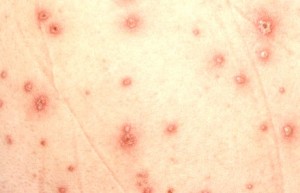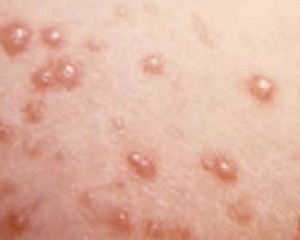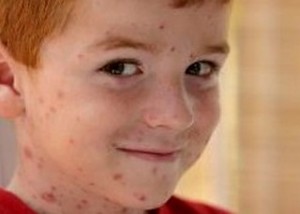Chickenpox in children is a common skin disease particularly on kids aged 12 and below. It is an airborne and a highly contagious disease that can spread easily through direct contact or through sneezing and coughing. It usually starts with a slight fever accompanied by sore throat and followed by small blisters that spread all over the body. A kid diagnosed with chickenpox is advised to stay at home and rest until completely healed.
Causes of Chickenpox
Chickenpox in children is usually caused by a virus called Varicella-Zoster virus (VZV). VZV is one of the herpes viruses that are known to infect humans. It is known that you’ll only get chickenpox once in your life, but once infected the virus will remain dormant in the nerve centres of the spine and the possibility of re-occurring in a different form of disease may happen later on in life.
Nowadays, most children between ages 12 and 15 months are given chickenpox vaccine to protect them against the virus. Later on when they reach 4 to 6 years old, they are given boosters for added protection. Though chickenpox is most common in children, the disease can infect individuals of all ages and chicken pox in adults are more severe compared to those in youngsters. As per advise from the Centers for Disease Control and Prevention (CDC), those who are 13 years and above should get at least 2 doses of chickenpox vaccine with at least 28 days apart.
How does Chickenpox spread?
The Chickenpox virus can easily be passed to anyone, from family members to friends and classmates. The virus is highly contagious especially at the early stages since the varicella-zoster virus is present in throat secretions even before the development of rashes. The virus can be passed through droplets of exhaled air and airborne particles. So be careful around children with chickenpox for they do not know how contagious they are.
The virus can be spread through fluids inside the blisters that can be transmitted through direct or indirect contact with the clothing and items that are contaminated with the fluid. Patients are contagious even five days before and after the rashes appear. Once all sores are crusted over and the chickenpox in children is completely healed they can go back to their normal activities.
Signs and Symptoms of Chickenpox in children
Before the rash appears, chickenpox in children is usually manifested by a slight fever, sore throat, abdominal pain, headache, and feeling sick for at least two days. The fever usually stays within the range of 37.7°-38.8° C (100°-102° F) and it rarely goes higher than that.
When the rashes emerge, they will start as small bumps that usually look like insect bites or pimples. Later on they will develop into thin-walled blisters filled with clear and watery fluid. These will then break and form into open sores which will eventually dry off and become brown scabs. The appearance of the rashes usually starts at the scalp, then down to the trunks, then finally to the arms and legs. The trunk is where most rashes are concentrated, specifically those areas that are most irritated with diaper rash and sunburn. These rashes are also quite itchy and are usually the size of a quarter of an inch.
Incubation Period for Chickenpox
The infectious period for chickenpox in children usually starts three days before the rashes appear and until the blisters form into scabs. When someone gets infected within this period, it takes at least 10 to 21 days for that person who got infected to manifest the signs and symptoms. The incubation period is the time between the infection happened and the instance when the symptoms start to appear.
Treatment for Chickenpox
Treatments for chickenpox in children are usually aimed at decreasing the symptoms the child is suffering from. Acetaminophen is usually prescribed to help decrease fever and aches. It should be noted that children should not be given aspirin because this medication imposes the threat of developing Reye’s syndrome. This syndrome causes brain swelling and diseases in the liver and kidneys which may also lead to death.
Treatments for the severe itching include home remedies like oatmeal bathing, cold compress and using moisturizing lotions that contain calamine that can be applied to the rashes. Other medications for itching are anti-histamine and diphenhydramine. These treatments are very helpful for kids who cannot stand severe itch. Antibiotics are only given when the sores have been infected with bacteria due to persistent scratching.
In some cases, acyclovir is prescribed to help shorten the disease duration. This medication is most effective only if given on the day or two from the onset of the rashes. This treatment is only prescribed to patients who have chances of acquiring more severe diseases.
Complications for Chickenpox
Though chickenpox is not a fatal disease, possible complications may still arise for chickenpox in children, the most common of which are caused by bacterial infection acquired through relentless scratching. Other rare complications include:
• Meningitis
• Pneumonia
• Encephalitis
• Inflammation in the heart
• Reye’s syndrome
As stated earlier, once infected, the virus will stay dormant inside the body and a possibility of developing shingles may occur especially during adulthood. Up to 20 % of those who experienced chickenpox as a child can develop shingles.
How to Care for Chickenpox in Children
Because chickenpox in children is very itchy, the kids cannot help themselves but try to scratch it. As much as possible control them from scratching to avoid infections and scars. Cut their nails short to avoid further infection and apply calamine lotion to help ease the itch. You can also apply home itch remedy such as oatmeal bath and give them frequent cool baths every 4 hours for at least a few days. Serve your kids with soft, cold and bland foods. Also avoid feeding them with acidic and salty foods and increase the fluid intake. Make sure that they are wearing cool and comfortable clothes, but most importantly, encourage the kids to have a good rest.



I am constantly looking online for tips that can facilitate me. Thanks!